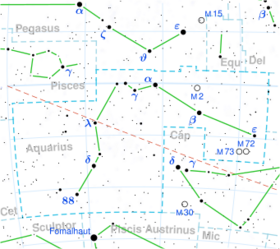Astronomy:83 Aquarii
From HandWiki
Short description: Binary star in the constellation Aquarius
| Observation data Equinox J2000.0]] (ICRS) | |
|---|---|
| Constellation | Aquarius |
| Right ascension | 23h 05m 09.78684s[1] |
| Declination | –07° 41′ 37.6853″[1] |
| Apparent magnitude (V) | 5.43[2] (6.20/6.34)[3] |
| Characteristics | |
| Spectral type | F2 Vn + F2 V[3] |
| U−B color index | +0.07[2] |
| B−V color index | +0.30[2] |
| Astrometry | |
| Radial velocity (Rv) | –13[4] km/s |
| Proper motion (μ) | RA: +122.41[1] mas/yr Dec.: +7.11[1] mas/yr |
| Parallax (π) | 15.57 ± 0.61[1] mas |
| Distance | 209 ± 8 ly (64 ± 3 pc) |
| Orbit[5] | |
| Companion | 83 Aquarii B |
| Period (P) | 21.840 ± 0.019 yr |
| Semi-major axis (a) | 0.2026 ± 0.0007″ |
| Eccentricity (e) | 0.3878 ± 0.0025 |
| Inclination (i) | 48.01 ± 0.42° |
| Longitude of the node (Ω) | 204.87 ± 0.50° |
| Periastron epoch (T) | 1983.108 ± 0.022 |
| Argument of periastron (ω) (secondary) | 82.83 ± 0.45° |
| Other designations | |
| Database references | |
| SIMBAD | data |
83 Aquarii (abbreviated 83 Aqr) is a binary star system in the equatorial constellation of Aquarius. The combined apparent visual magnitude of the pair is 5.43,[2] which is faintly visible to the naked eye. Based upon an annual parallax shift of 15.57 milliarcseconds,[1] it is located at a distance of around 209 light-years (64 parsecs) from Earth.
Both stars are F-type main sequence stars.[3] The first component has an apparent magnitude of 6.20; the second is magnitude 6.34.[3] They are orbiting each other with a period of 21.84 years with an eccentricity of 0.388.[5]
References
- ↑ 1.0 1.1 1.2 1.3 1.4 1.5 van Leeuwen, F. (November 2007), "Validation of the new Hipparcos reduction", Astronomy and Astrophysics 474 (2): 653–664, doi:10.1051/0004-6361:20078357, Bibcode: 2007A&A...474..653V.
- ↑ 2.0 2.1 2.2 2.3 Nicolet, B. (October 1978), "Catalogue of homogeneous data in the UBV photoelectric photometric system", Astronomy and Astrophysics Supplement Series 34: 1–49, Bibcode: 1978A&AS...34....1N.
- ↑ 3.0 3.1 3.2 3.3 Eggleton, P. P.; Tokovinin, A. A. (September 2008), "A catalogue of multiplicity among bright stellar systems", Monthly Notices of the Royal Astronomical Society 389 (2): 869–879, doi:10.1111/j.1365-2966.2008.13596.x, Bibcode: 2008MNRAS.389..869E.
- ↑ Wilson, Ralph Elmer (1953), "General Catalogue of Stellar Radial Velocities", Carnegie Institute Washington D.C. Publication (Washington: Carnegie Institution of Washington), Bibcode: 1953GCRV..C......0W.
- ↑ 5.0 5.1 Hartkopf, W. I.; Mason, B. D.; McAlister, H. A. (1996), "Binary star orbits from speckle interferometry. VIII. Orbits of 37 close visual systems", Astronomical Journal 111: 370–392, doi:10.1086/117790, Bibcode: 1996AJ....111..370H.
- ↑ Kostjuk, N. D. (2004). "VizieR Online Data Catalog: HD-DM-GC-HR-HIP-Bayer-Flamsteed Cross Index (Kostjuk, 2002)". VizieR On-line Data Catalog: IV/27A. Originally Published in: Institute of Astronomy of Russian Academy of Sciences (2002) 4027. Bibcode: 2004yCat.4027....0K.
- ↑ "* 83 Aqr". SIMBAD. Centre de données astronomiques de Strasbourg. http://simbad.u-strasbg.fr/simbad/sim-basic?Ident=%2A+83+Aqr.
External links
 |


